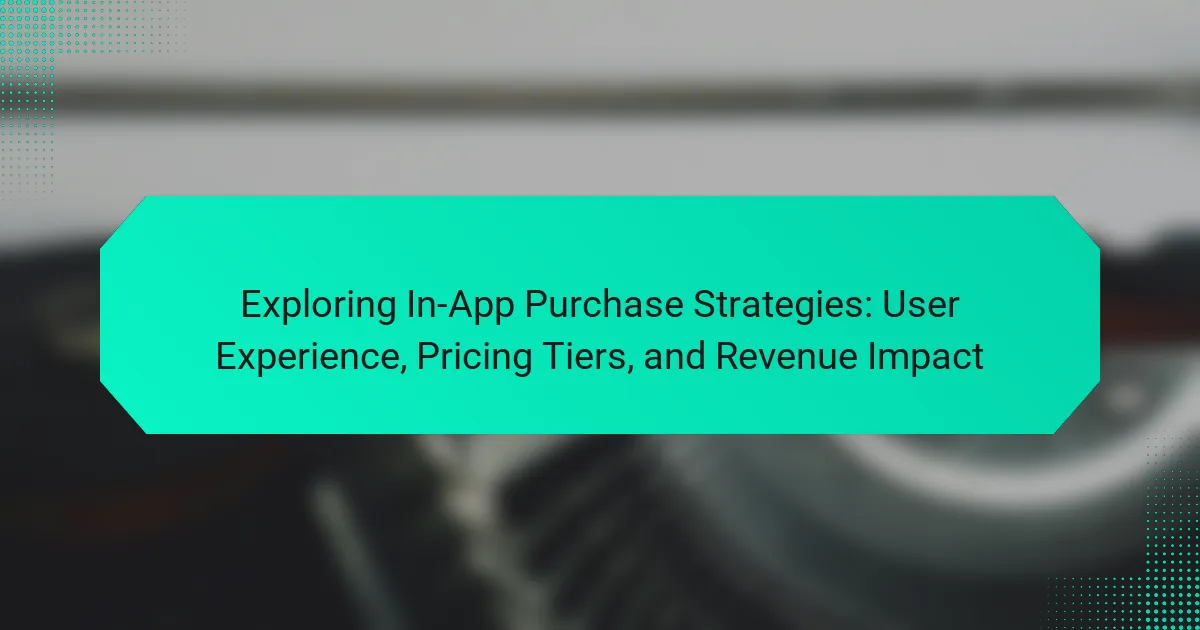In-app purchase strategies are essential methods employed by app developers to generate revenue through additional content or features within applications. This article explores various strategies, including tiered pricing options, limited-time offers, and subscription models, highlighting their impact on user experience and revenue potential. It emphasizes the importance of in-app purchases, such as in-game currency, in driving user engagement and retention. Recent research indicates that these strategies significantly contribute to mobile app revenue, with in-app purchases accounting for over 50% of total earnings in the industry.

What are In-App Purchase Strategies?
In-app purchase strategies are methods used by app developers to monetize their applications through additional content or features. These strategies often include offering tiered pricing options, limited-time offers, and subscription models. They aim to enhance user experience while maximizing revenue potential. For example, a game may provide in-game currency as an in-app purchase, encouraging users to spend more. Research shows that apps utilizing effective in-app purchase strategies can increase user engagement and retention significantly. A study by Statista indicated that in-app purchases accounted for over 50% of mobile app revenue in recent years.
How do In-App Purchase Strategies enhance user experience?
In-app purchase strategies enhance user experience by providing tailored content and features. These strategies allow users to access premium features that improve engagement. For example, users can unlock additional game levels or exclusive content. This personalization increases user satisfaction and retention rates. According to a report by Statista, 79% of mobile gamers make in-app purchases. This statistic highlights the demand for enhanced experiences through these strategies. Furthermore, in-app purchases can offer users a sense of achievement and progression. This gamification aspect keeps users motivated to continue interacting with the app. Overall, in-app purchase strategies create a more enjoyable and rewarding user experience.
What role does user interface design play in In-App Purchase Strategies?
User interface design plays a critical role in in-app purchase strategies by influencing user engagement and conversion rates. A well-designed interface enhances usability, making it easier for users to navigate purchase options. Clear visual hierarchies guide users to key features and offers. Intuitive layouts reduce friction during the purchasing process. Additionally, appealing aesthetics can attract users and encourage them to spend. Research indicates that 70% of users abandon purchases due to poor interface design. Therefore, effective UI design is essential for maximizing revenue through in-app purchases.
How can personalization improve user engagement with in-app purchases?
Personalization can significantly enhance user engagement with in-app purchases. Tailored recommendations based on user behavior increase the likelihood of purchase. Users are more inclined to buy items that align with their preferences and usage patterns. For instance, apps that analyze past purchases and suggest relevant products see higher conversion rates. A study by McKinsey & Company found that personalized experiences can lead to a 10-30% increase in engagement. Additionally, offering personalized discounts or promotions can further incentivize users to make purchases. This targeted approach fosters a sense of connection and relevance, ultimately driving sales.
What types of pricing tiers are commonly used in In-App Purchases?
Freemium, subscription, one-time purchase, and consumable purchases are common pricing tiers in in-app purchases. Freemium models offer basic features for free while charging for premium content. Subscription tiers require users to pay regularly for ongoing access to content or features. One-time purchases allow users to buy features or content outright without recurring fees. Consumable purchases enable users to buy items that can be used once or have a limited lifespan. These pricing strategies cater to different user preferences and maximize revenue potential.
How do different pricing tiers affect user decision-making?
Different pricing tiers significantly influence user decision-making. Users often perceive value differently based on the tier they select. Higher pricing tiers may suggest premium features or enhanced experiences. This perception can lead users to choose more expensive options, believing they will receive better quality. Conversely, lower pricing tiers may attract budget-conscious users. Research indicates that users often compare tiers before making a decision. A study published in the Journal of Marketing found that clear differentiation between tiers enhances user choices. Users are more likely to make a purchase when they understand the benefits associated with each tier. Thus, pricing tiers play a crucial role in shaping user preferences and decisions.
What are the advantages of offering multiple pricing options?
Offering multiple pricing options increases customer satisfaction and enhances sales potential. It caters to diverse customer preferences and budgets. Research indicates that 60% of consumers prefer to choose from several pricing tiers. This flexibility can lead to higher conversion rates. Additionally, it allows businesses to target different market segments effectively. Offering varied pricing can also reduce buyer’s remorse by providing perceived value. In summary, multiple pricing options can improve user experience and boost overall revenue.
What is the revenue impact of In-App Purchase Strategies?
In-app purchase strategies significantly enhance revenue for mobile applications. These strategies allow users to buy additional content or features directly within the app. Research by Sensor Tower indicates that apps utilizing in-app purchases generated over $100 billion in revenue in 2020 alone. This growth is attributed to the ability to offer tiered pricing models, which cater to various user preferences. Additionally, effective in-app purchase strategies can increase user engagement, leading to higher retention rates. A study by App Annie revealed that apps with well-implemented in-app purchases saw a 30% increase in average revenue per user. Thus, the revenue impact of in-app purchase strategies is substantial and quantifiable.
How do In-App Purchase Strategies influence overall revenue growth?
In-app purchase strategies significantly influence overall revenue growth by enhancing monetization opportunities. These strategies enable developers to offer additional content, features, or upgrades, enticing users to spend more. For example, a study by Statista indicates that mobile games generated over $77 billion in revenue in 2020, with in-app purchases accounting for a substantial portion.
Effective pricing tiers can maximize user engagement and spending. By offering various price points, developers cater to different user segments. Research conducted by App Annie shows that apps with multiple in-app purchase options see a higher average revenue per user.
Additionally, targeted promotions and limited-time offers can create urgency, encouraging users to make purchases. This tactic can lead to spikes in revenue during promotional periods.
Overall, well-implemented in-app purchase strategies can lead to sustained revenue growth by increasing user retention and spending.
What metrics should be monitored to measure revenue impact?
Key metrics to monitor for measuring revenue impact include Average Revenue Per User (ARPU), Customer Lifetime Value (CLV), and conversion rates. ARPU indicates the revenue generated per user over a specific period. According to a report by Statista, ARPU in mobile gaming reached $0.90 in 2020. CLV helps predict the total revenue from a customer throughout their engagement. Research from HubSpot states that increasing customer retention by just 5% can boost profits by 25% to 95%. Conversion rates measure the percentage of users making purchases, with benchmarks often around 2-5% in mobile apps. Tracking these metrics provides insight into revenue performance and user engagement.
How can In-App Purchase Strategies be optimized for better performance?
In-app purchase strategies can be optimized for better performance by implementing targeted pricing tiers. Offering a range of pricing options caters to diverse user preferences. Data shows that users are more likely to make purchases when presented with multiple price points. Additionally, enhancing user experience through streamlined purchase processes can reduce friction. Simplifying the checkout flow increases conversion rates significantly. Personalized recommendations based on user behavior can also drive sales. Research indicates that tailored offers can boost engagement and spending. Regularly analyzing purchase data allows for continuous strategy refinement. By adjusting strategies based on user feedback and purchasing trends, developers can maximize revenue potential.
What best practices should be followed when implementing In-App Purchase Strategies?
Implementing effective in-app purchase strategies requires several best practices. First, understand your user base and their spending behavior. Conduct market research to identify user preferences and willingness to pay. Second, offer clear value propositions for each in-app purchase. Users should easily see the benefits of spending money. Third, ensure a seamless purchasing process. Complicated steps can lead to cart abandonment. Fourth, utilize tiered pricing strategies. Offering multiple price points can cater to different user segments. Fifth, incorporate limited-time offers to create urgency. This can encourage users to make quicker purchasing decisions. Finally, regularly analyze purchase data to refine strategies. Continuous improvement based on user feedback and purchasing trends is crucial.
How can user feedback be utilized to refine In-App Purchase offerings?
User feedback can be utilized to refine In-App Purchase offerings by identifying user preferences and pain points. Analyzing feedback allows developers to understand which features are most valued. This insight helps in adjusting pricing tiers to match user expectations. Additionally, feedback can reveal which items are underperforming, guiding decisions on potential improvements or removals. Surveys and reviews provide direct user input, offering qualitative data for refinement. A/B testing of different offerings based on feedback can optimize conversion rates. Implementing changes based on user suggestions fosters a sense of community and loyalty. Regularly updating offerings in response to feedback keeps the app relevant and engaging.
What challenges may arise with In-App Purchase Strategies?
Challenges with in-app purchase strategies include user resistance to spending. Many users may perceive in-app purchases as excessive or unnecessary. This perception can lead to negative reviews and decreased user retention. Additionally, pricing tiers can confuse users, making it difficult for them to understand the value proposition. Technical issues can also arise, such as payment processing failures or app crashes during transactions. These problems can frustrate users and lead to abandoned purchases. Moreover, regulatory compliance can pose challenges, as different regions have varying laws regarding digital transactions. Lastly, competition in the app market can pressure developers to reduce prices, impacting profitability.
How can developers address common user objections to in-app purchases?
Developers can address common user objections to in-app purchases by implementing transparent pricing and value propositions. Clear communication about the benefits of in-app purchases helps users understand their value. Offering free trials or limited-time promotions can also reduce resistance. Providing options for different pricing tiers accommodates various user budgets. Incorporating user feedback into updates shows responsiveness to concerns. Additionally, ensuring that in-app purchases enhance gameplay without being necessary for progression can improve user satisfaction. Research indicates that 70% of users prefer apps that offer in-app purchases perceived as fair and valuable.
What strategies can mitigate the risk of user churn related to pricing?
Implementing tiered pricing can effectively mitigate the risk of user churn related to pricing. Tiered pricing allows users to choose a plan that best fits their budget and needs. This flexibility can lead to higher user satisfaction and retention. Offering discounts for long-term commitments also reduces churn. Users are more likely to stay if they perceive they are receiving a good deal. Regularly analyzing user feedback can provide insights into pricing perceptions. Adjusting pricing strategies based on this feedback can enhance user engagement. Additionally, providing clear value propositions for each pricing tier can help users understand what they are paying for. This clarity can reduce confusion and dissatisfaction, further decreasing churn rates.
What are the future trends in In-App Purchase Strategies?
Future trends in in-app purchase strategies include personalized offerings, subscription models, and enhanced user experience. Personalized offerings leverage user data to recommend specific items, increasing conversion rates. Subscription models provide steady revenue streams and improve user retention. Enhanced user experience focuses on seamless transactions and engaging interfaces.
According to a report by App Annie, in-app purchases are projected to reach $100 billion by 2024, highlighting the importance of these strategies. Moreover, a survey by Statista indicates that 58% of mobile gamers prefer subscription services over traditional one-time purchases. These trends indicate a shift towards more user-centric approaches in monetization.
How might emerging technologies shape the future of in-app purchases?
Emerging technologies will significantly shape the future of in-app purchases through enhanced personalization and streamlined payment processes. Artificial intelligence can analyze user behavior to recommend tailored in-app purchases. This increases conversion rates as users receive suggestions aligned with their preferences. Blockchain technology can provide secure and transparent transactions, enhancing trust in in-app purchases. Virtual and augmented reality can create immersive shopping experiences, encouraging users to engage more with in-app content. Additionally, advancements in mobile payment systems will simplify the checkout process, reducing friction and abandonment rates. These technologies collectively aim to improve user experience and drive revenue growth for app developers.
What role will data analytics play in evolving In-App Purchase Strategies?
Data analytics will significantly enhance In-App Purchase strategies by providing insights into user behavior. It enables developers to identify purchasing patterns and preferences. This information allows for tailored offerings that resonate with users. For instance, analytics can reveal peak purchasing times and popular items. Companies can adjust pricing tiers based on this data. According to a report by Statista, apps utilizing data analytics see up to a 30% increase in revenue. Furthermore, A/B testing driven by data can optimize user experience and conversion rates. Overall, data analytics is crucial for informed decision-making in In-App Purchase strategies.
What practical tips can help improve In-App Purchase Strategies?
To improve In-App Purchase strategies, focus on optimizing user experience and pricing tiers. Streamline the purchase process to reduce friction. Implement clear calls-to-action that guide users towards purchases. Use tiered pricing to cater to different user segments. Offer limited-time discounts to create urgency. Regularly analyze user behavior to identify trends and preferences. Personalize offers based on user activity and purchase history. Provide transparent information on what users receive with each purchase.
The main entity of the article is In-App Purchase Strategies, which are methods employed by app developers to monetize applications through additional content or features. The article explores how these strategies enhance user experience, the role of user interface design, and the impact of pricing tiers on user decision-making. It discusses the revenue implications of in-app purchases, effective optimization techniques, and future trends influenced by emerging technologies and data analytics. Additionally, it addresses challenges developers face and practical tips for refining in-app purchase offerings to maximize user engagement and revenue growth.


